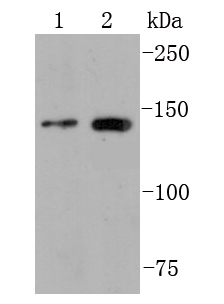Product Name :
FGFR2 polyclonal antibody Background :
Acidic and basic fibroblast growth factors (FGFs) are members of a family of multifunctional polypeptide growth factors that stimulate proliferation of cells of mesenchymal, epithelial and neuroectodermal origin. Like other growth factors, FGFs act by binding and activating specific cell surface receptors. These include the Flg receptor or FGFR-1, the Bek receptor (or FGFR-2), FGFR-3, FGFR-4, FGFR-5 and FGFR-6. These receptors usually contain an extracellular ligand-binding region containing three immunoglobulin-like domains, a transmembrane domain and a cytoplasmic tyrosine kinase domain. The gene encoding human Bek (also designated K-sam) maps to chromosome 10q26.13 and is alternatively spliced to produce several isoforms. Heterogeneous mutations in Bek are associated with a range of craniosynostosis syndromes including Pfeiffer syndrome, Crouzon syndrome, Jackson-Weiss syndrome and Apert syndrome.. Product :
Rabbit IgG, 1mg/ml in PBS with 0.02% sodium azide, 50% glycerol, pH7.2 Storage&Stability :
Store at +4°C after thawing. Aliquot store at -20°C or -80°C. Avoid repeated freeze / thaw cycles. Specificity :
FGFR2 polyclonal antibody detects endogenous levels of FGFR2 protein. Immunogen :
recombinant protein Conjugate :
Unconjugated Modification :
Unmodification
FGFR2 polyclonal antibody Background :
Acidic and basic fibroblast growth factors (FGFs) are members of a family of multifunctional polypeptide growth factors that stimulate proliferation of cells of mesenchymal, epithelial and neuroectodermal origin. Like other growth factors, FGFs act by binding and activating specific cell surface receptors. These include the Flg receptor or FGFR-1, the Bek receptor (or FGFR-2), FGFR-3, FGFR-4, FGFR-5 and FGFR-6. These receptors usually contain an extracellular ligand-binding region containing three immunoglobulin-like domains, a transmembrane domain and a cytoplasmic tyrosine kinase domain. The gene encoding human Bek (also designated K-sam) maps to chromosome 10q26.13 and is alternatively spliced to produce several isoforms. Heterogeneous mutations in Bek are associated with a range of craniosynostosis syndromes including Pfeiffer syndrome, Crouzon syndrome, Jackson-Weiss syndrome and Apert syndrome.. Product :
Rabbit IgG, 1mg/ml in PBS with 0.02% sodium azide, 50% glycerol, pH7.2 Storage&Stability :
Store at +4°C after thawing. Aliquot store at -20°C or -80°C. Avoid repeated freeze / thaw cycles. Specificity :
FGFR2 polyclonal antibody detects endogenous levels of FGFR2 protein. Immunogen :
recombinant protein Conjugate :
Unconjugated Modification :
Unmodification
-
 Western blot analysis of FGFR2 on different cell lysates using anti-PGFR2 antibody at 1/1,000 dilution. Positive control: Lane 1:MCF-7 Lane 2: Jurkat
Western blot analysis of FGFR2 on different cell lysates using anti-PGFR2 antibody at 1/1,000 dilution. Positive control: Lane 1:MCF-7 Lane 2: Jurkat
Bioworld Biotech only provide peptides for our antibodies and do not provide additional peptide customization services.
Price/Size :
USD 368/1mg/vial
Tips:
For phospho antibody, we provide phospho peptide(0.5mg) and non-phospho peptide(0.5mg).Describe :
Blocking peptides are peptides that bind specifically to the target antibody and block antibody binding. These peptide usually contains the epitope recognized by the antibody. Antibodies bound to the blocking peptide no longer bind to the epitope on the target protein. This mechanism is useful when non-specific binding is an issue, for example, in Western blotting (WB) and Immunohistochemistry (IHC). By comparing the staining from the blocked antibody versus the antibody alone, one can see which staining is specific; Specific binding will be absent from the western blot or IHC performed with the neutralized antibody.Formula:
Synthetic peptide was lyophilized with 100% acetonitrile and is supplied as a powder. Reconstitute with 0.1 ml DI water for a final concentration of 10 mg/ml.The purity is >90%,tested by HPLC and MS.
Storage:
The freeze-dried powder is more stable. For short time at 2-8°C. For long term storage store at -20°C.
Note :
This product is for research use only (RUO only). Not for use in diagnostic or therapeutic procedures.
 FGFR2 polyclonal antibody
FGFR2 polyclonal antibody  Datasheet
Datasheet COA
COA MSDS
MSDS SHIP
SHIP